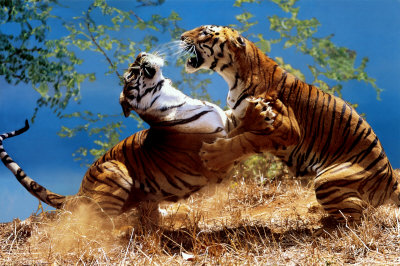Source google.com
Wild Tigers
Siberian (or Amur) tigers are the world's largest cats. They live primarily in eastern Russia's birch forests, though some exist in China and North Korea. There are an estimated 400 to 500 Siberian tigers living in the wild, and recent studies suggest that these numbers are stable. Though their northern climate is far harsher than those of other tigers, these animals have some advantages. Northern forests offer the lowest human density of any tiger habitat, and the most complete ecosystem. The vast woodlands also allow tigers far more room to roam, as Russia's timber industry is currently less extensive than that of many other countries.
Tigers are the largest of all wild cats and are renowned for their power and strength. There were once eight tiger subspecies, but three became extinct during the 20th century. Over the last hundred years, hunting and forest destruction have reduced overall tiger populations from hundreds of thousands to perhaps 3,000 to 5,000. Tigers are hunted as trophies and also for body parts that are used in traditional Chinese medicine. All five remaining tiger subspecies are endangered, and many protection programs are in place. Poaching is a reduced—but still very significant—threat to Siberian tigers.
Tigers live alone and aggressively scent-mark large territories to keep their rivals away. They are powerful hunters that travel many miles to find prey, such as elk and wild boar, on nocturnal hunts. Tigers use their distinctive coats as camouflage (no two have exactly the same stripes) and hunt by stealth. They lie in wait and creep close enough to attack their victims with a quick spring and a fatal pounce. A hungry tiger can eat as much as 60 pounds (27 kilograms) in one night, though they usually eat less.
Despite their fearsome reputation, most tigers avoid humans; however, a few do become dangerous maneaters. These animals are often sick and unable to hunt normally, or live in areas where their traditional prey has vanished.
Females give birth to litters of two to six cubs, which they raise with little or no help from the male. Cubs cannot hunt until they are 18 months old, and remain with their mothers for two to three years, when they disperse to find their own territory.





Wild Tigers
Siberian (or Amur) tigers are the world's largest cats. They live primarily in eastern Russia's birch forests, though some exist in China and North Korea. There are an estimated 400 to 500 Siberian tigers living in the wild, and recent studies suggest that these numbers are stable. Though their northern climate is far harsher than those of other tigers, these animals have some advantages. Northern forests offer the lowest human density of any tiger habitat, and the most complete ecosystem. The vast woodlands also allow tigers far more room to roam, as Russia's timber industry is currently less extensive than that of many other countries.
Tigers are the largest of all wild cats and are renowned for their power and strength. There were once eight tiger subspecies, but three became extinct during the 20th century. Over the last hundred years, hunting and forest destruction have reduced overall tiger populations from hundreds of thousands to perhaps 3,000 to 5,000. Tigers are hunted as trophies and also for body parts that are used in traditional Chinese medicine. All five remaining tiger subspecies are endangered, and many protection programs are in place. Poaching is a reduced—but still very significant—threat to Siberian tigers.
Tigers live alone and aggressively scent-mark large territories to keep their rivals away. They are powerful hunters that travel many miles to find prey, such as elk and wild boar, on nocturnal hunts. Tigers use their distinctive coats as camouflage (no two have exactly the same stripes) and hunt by stealth. They lie in wait and creep close enough to attack their victims with a quick spring and a fatal pounce. A hungry tiger can eat as much as 60 pounds (27 kilograms) in one night, though they usually eat less.
Despite their fearsome reputation, most tigers avoid humans; however, a few do become dangerous maneaters. These animals are often sick and unable to hunt normally, or live in areas where their traditional prey has vanished.
Females give birth to litters of two to six cubs, which they raise with little or no help from the male. Cubs cannot hunt until they are 18 months old, and remain with their mothers for two to three years, when they disperse to find their own territory.
Wild Tigers Fighting

Wild Tigers Fighting

Wild Tigers Fighting

Wild Tigers Fighting

Wild Tigers Fighting

Wild Tigers Fighting

No comments:
Post a Comment